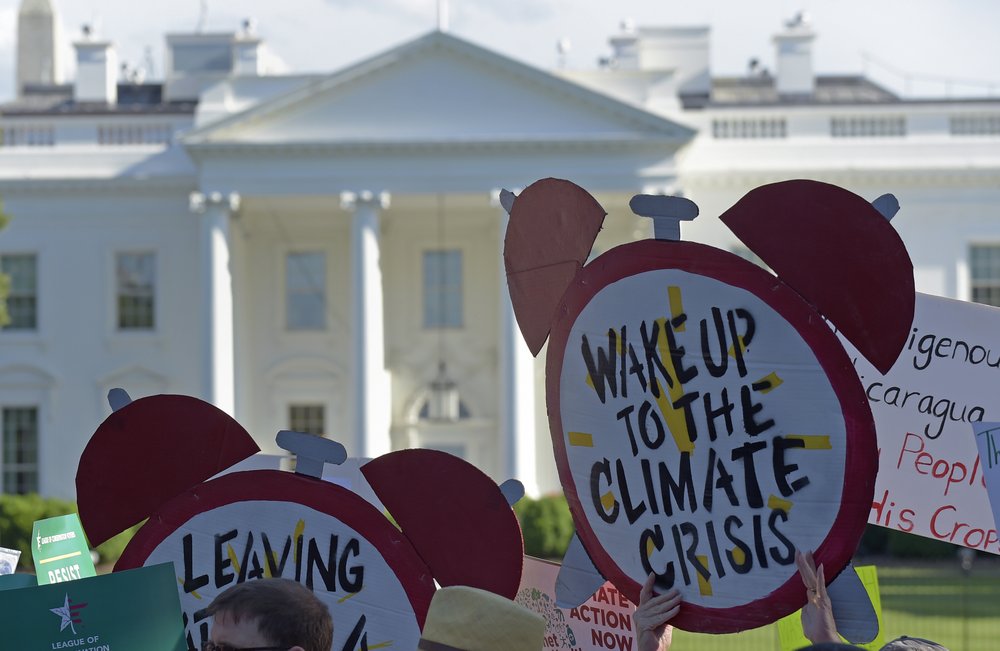National
Trump can begin steps to pull US out of Paris climate deal

WASHINGTON (AP) — For more than two years President Donald Trump has talked about pulling the United States out of the landmark Paris climate agreement . Starting Monday he finally can do something about it.
Even then, though, the withdrawal process takes a year and wouldn’t become official until at least the day after the 2020 presidential election.
In the Paris agreement, nearly 200 countries set their own national targets for reducing or controlling pollution of heat-trapping gases. It was negotiated in 2015 with lots of prodding by the United States and China and went into effect Nov. 4, 2016.
The terms of the deal say no country can withdraw in the first three years. So Monday is the first time the U.S. could actually start the withdrawal process, which begins with a letter to the United Nations. And it doesn’t become official for a year after that, which leads to the day after the election.
If someone other than Trump wins in 2020, the next president could get back in the deal in just 30 days and plan to cut carbon pollution, said Andrew Light, a former Obama State Department climate negotiator now at the nonprofit World Resources Institute.
Light and other experts say the withdrawal by the United States, the second biggest climate polluter and world’s largest economy, will hurt efforts to fight global warming.
“Global objectives can’t be met unless everybody does their part and the U.S. has to play the game,” said Appalachian State University environmental sciences professor Gregg Marland, who is part of a global effort to track carbon dioxide emissions. “We’re the second biggest player. What happens to the game if we take our ball and go home?”
Someone else, probably the biggest polluter China, will take over leadership in the global fight, said MIT economist Jake Jacoby, who co-founded the MIT Joint Program on the Science and Policy of Global Change.
The penalty for the U.S. “is not in economic loss. The penalty is in shame, in discrediting U.S. leadership,” Jacoby said.
Asked what the U.S. plans next, State Department spokesman James Dewey on Friday emailed only this: “The U.S. position with respect to the Paris Agreement has not changed. The United States intends to withdraw from the Paris Agreement.”
The agreement set goals of preventing another 0.9 degrees (0.5 degrees Celsius) to 1.8 degrees (1 degree Celsius) of warming from current levels. Even the pledges made in 2015 weren’t enough to prevent those levels of warming.
The deal calls for nations to come up with more ambitious pollution cuts every five years, starting in November 2020 in at a meeting in Scotland. Because of the expected withdrawal, the U.S. role in 2020 negotiations will be reduced, Light said.
Climate change, caused by the burning of coal, oil and gas, has already warmed the world by 1.8 degrees (1 degree Celsius) since the late 1800s, caused massive melting of ice globally, triggered weather extremes and changed ocean chemistry. And scientists say, depending on how much carbon dioxide is emitted, it will only get worse by the end of the century with temperatures jumping by several degrees and oceans rising by close to three feet (1 meter).
Trump has been promising to pull out of the Paris deal since 2017, often mischaracterizing the terms of the agreement, which are voluntary. In October, he called it a massive wealth transfer from America to other nations and said it was one-sided
That’s not the case, experts said.
For example, the U.S. goal — set by Barack Obama’s administration — had been to reduce carbon dioxide emission in 2025 by 26% to 28% compared to 2005 levels. This translates to about 15% compared to 1990 levels.
The European Union’s goal was to cut carbon pollution in 2030 by 40% compared to 1990 levels, which is greater than America’s pledge, said Stanford University’s Rob Jackson, who chairs the Global Carbon Project, a group of scientists that track carbon emissions worldwide. The United Kingdom has already exceeded that goal, he said.
“The U.S. agreement is not a tax on the American people. There is no massive wealth transfer,” said Climate Advisers CEO Nigel Purvis, who was a lead State Department climate negotiator in the Clinton and George W. Bush administrations. “In fact, the agreement obligates no country to make any financial payments.”
Formally getting out of the Paris agreement is bad, but at this point after years of rhetoric is more symbolic than anything, said Georgia Tech climate scientist Kim Cobb. She said she is more worried about other Trump carbon pollution actions, such as fighting California’s tougher emissions and mileage standards and rollbacks of coal fired power plant regulations.
The U.S. was not on track to reach its Paris pledge, according to the federal Energy Information Administration’s latest projections.
The EIA projects that in 2025 emissions will be at 4959 million metric tons of carbon dioxide, 17% below 2005 levels, about 500 million tons short of the goal. Emissions in 2018 were nearly 2% higher than in 2016, the agency’s latest energy outlook says. That spike likely was from extreme weather and economic growth, Marland and Jacoby said.
__
Read more stories on climate issues by The Associated Press at https://www.apnews.com/Climate
Follow Seth Borenstein on Twitter at https://twitter.com/borenbears
The Associated Press Health and Science Department receives support from the Howard Hughes Medical Institute’s Department of Science Education. The AP is solely responsible for all content






